Day 2 of a three day long weekend of Early Winter Tours today. It was a nice, bright start to the morning and, although it clouded over later, it stayed largely dry until dark.
As we made our way east along the coast road, we thought we might stop for a better look at the Cattle Egrets. We were looking into the sun and the cows were huddled in one corner of the field, but there appeared to be white shapes in with them as we drove past. We parked in the layby just beyond and crossed the road. A flock of Fieldfares flew across the field, landing in the hedge close to where we parked and started tucking in to the berries. As we walked down along the path, we flushed a couple of Blackbirds and a Song Thrush from the bushes there. A Stock Dove flew out of the game cover as we passed.
When we got down to the corner overlooking the wet grazing marsh where the cows were, we couldn’t see any sign of the Cattle Egrets. The cows were on the edge of a ditch, so we wondered whether the egrets might be hiding at first. While we waited to see if they might emerge, we scanned the pools in the grass. There was a nice selection of ducks – Shelduck, Wigeon, Teal and a single female Pintail with them too. A scattering of Black-tailed Godwits were feeding around the muddy edge.
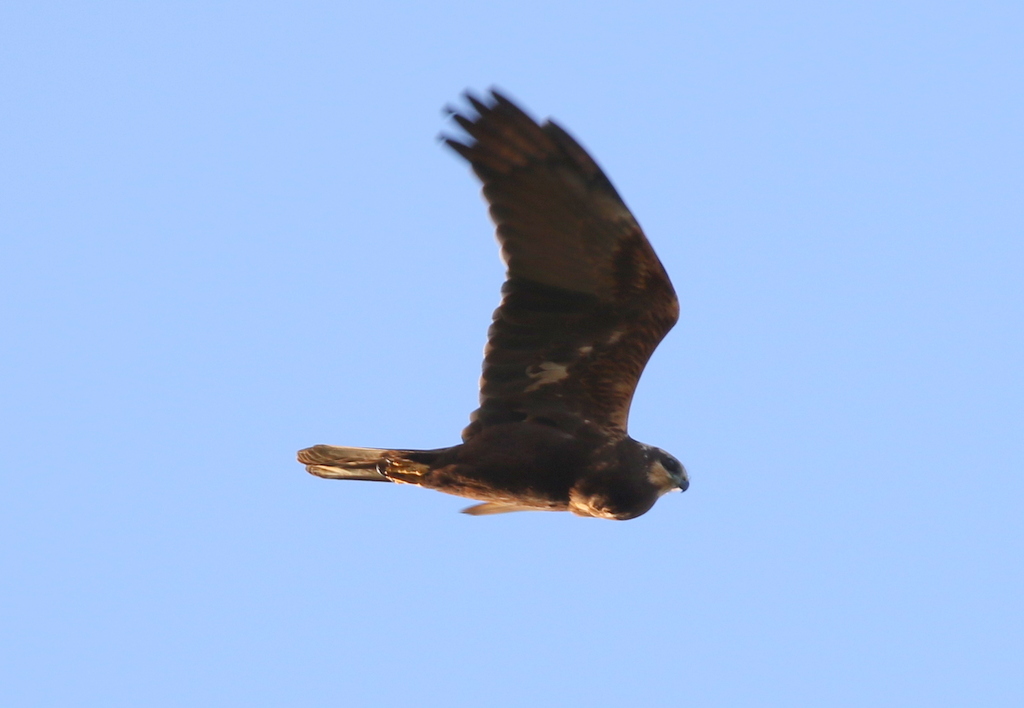 Marsh Harrier – flew over our heads early this morning
Marsh Harrier – flew over our heads early this morning
A flock of Long-tailed Tits came along the hedge past us, calling noisily. A Marsh Harrier circled up over the trees behind us before flying over our heads. A Yellowhammer flew over the road calling. And it quickly became clear that the Cattle Egrets weren’t there. We would be coming back this way later, so we decided not to linger and headed back to the car.
As we made our way on east past Cley, we could see a small flock of Brent Geese feeding on the grazing marsh by the entrance to Babcock Hide. There was nothing behind us, so we pulled up and had a quick look at them from the car. One immediately stood out – more contrasting than the regular Dark-bellied Brents, blacker bodied with a brighter white flank patch. It was the Black Brant. We managed to get a quick look at it before something spooked the geese and they all took off. They circled round and dropped down onto Watling Water, out of view.
Our next stop was at Weybourne. We decided to have a quick look at the beach first. There were a couple of groups of gulls on the shingle but nothing particularly interesting with them today – a mixture of Herring Gulls and Great Black-backed Gulls. A couple of Lesser Black-backed Gulls flew past together with a Great Black-backed Gull, giving a great side-by-side comparison.
There were several Turnstones down on the beach too, although they should perhaps have been better named Turn-fish today. A large number of small flatfish were washed up after last weekend’s storms and have been providing sustenance for the gulls and the Turnstones.
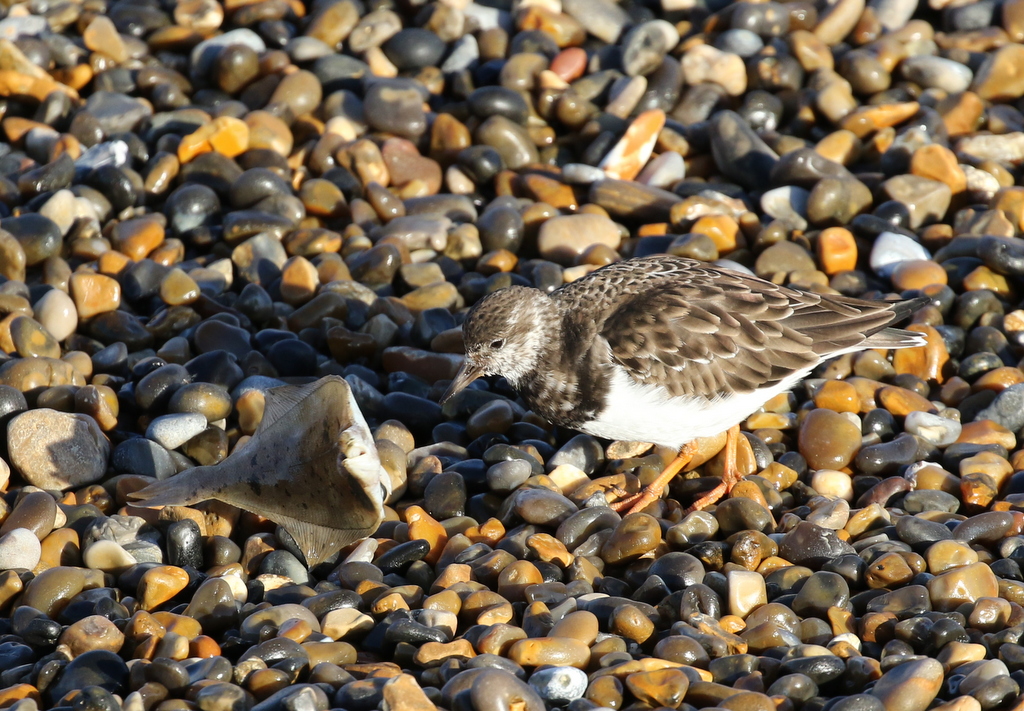 Turnstone – turning over a flatfish instead!
Turnstone – turning over a flatfish instead!
One of the group spotted a Great Crested Grebe flying past just offshore. It is quite an incongruous sight, but they winter quite commonly on the sea here. A single Ringed Plover flew past some way out too, presumably a fresh arrival coming in for the winter. Two Gannets circled way out on the horizon, catching the sun. A Rock Pipit flew west over the beach along with a Meadow Pipit. Otherwise there was not much happening out at sea this morning, so we decided to explore the fields instead.
As we walked up the hill on the edge of the grass beside the stubble, we flushed several Skylarks which flew round and landed again out in the field. A little group of Meadow Pipits flew up from the grass calling. Then up towards the top of the field, a large flock of Linnets flew up from the stubble and wheeled round before landing again. We had really come to look for Lapland Buntings, a few of which have been in the stubble here in recent days, but at first we couldn’t find any.
As we got up towards the old Coastguard Cottages, we could see more activity out in the middle of the field so we thought we would try walking up along the track towards the mill. We would not be looking into the sun from there too, as we had been from the cliff side. When we got to the field gate half way up the track, we stopped to scan and were instantly rewarded with a Lapland Bunting. Even better, it was out in an open area of bare mud, where we could get it in the scope. Great views – we couldn’t believe our luck! They are more often just seen flying round or skulking in the stubble.
 Lapland Bunting – showed very well on an area of bare mud
Lapland Bunting – showed very well on an area of bare mud
We watched the Lapland Bunting for some time. It was strikingly pale, off-white below and around the face. It appeared to be a male, with a ghosting of a black bib. It was feeding with a couple of Skylarks and Linnets. It would disappear into the furrows from time to time and then reappear somewhere different. At one point it looked like it might be bathing in a furrow with a couple of Meadow Pipits. Then a Weasel appeared. It ran across the field to the open muddy area and all the birds started to chase after it, mobbing it.
After the Weasel had been seen off, all the birds flew round and the Lapland Bunting circled over the open area again before heading out across the field. A second Lapland Bunting appeared from somewhere and followed it, the two of them then dropping down into the stubble out of view.
Our next destination was Kelling Water Meadow. As we walked up the lane, there were a few Blackbirds still in the hedges, arrivals from the continent for the winter stopping off here to refuel on the berries. Otherwise, there were just a few Chaffinches on the walk out until we got to where the thick hedges run out. Then a female Stonechat flew up from the grassy verge and landed in a hawthorn beside us.
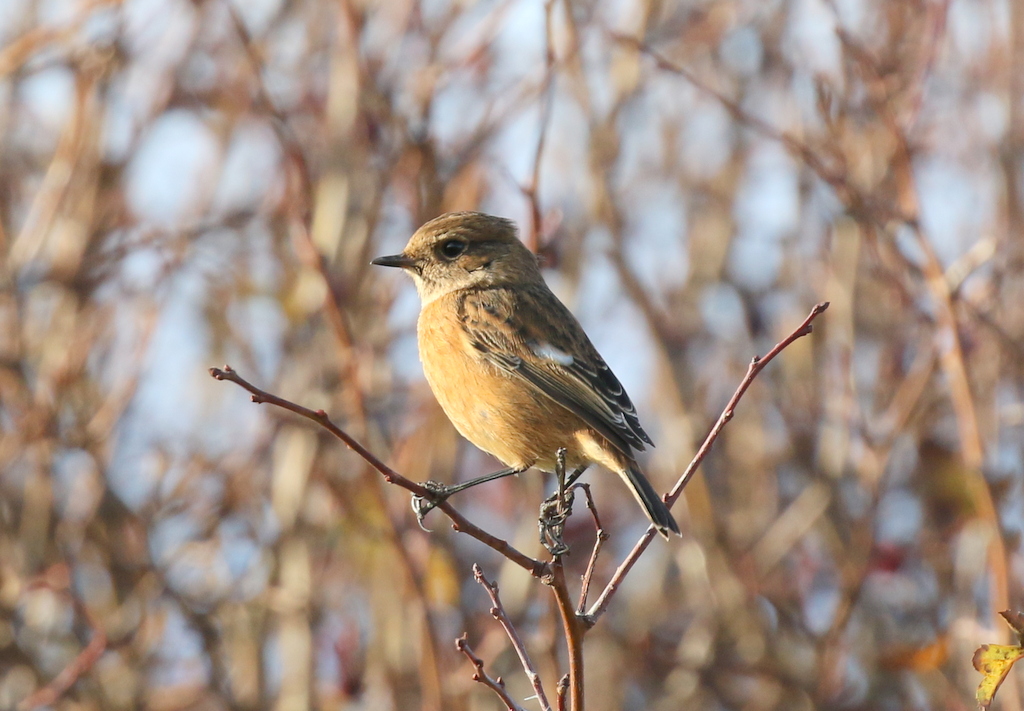 Stonechat – this female flew up from the verge beside us
Stonechat – this female flew up from the verge beside us
There did not appear to be many birds on the pool here today. Three Teal were feeding at the back. One of the things we had hoped to see was the Spotted Redshank which has been lingering here for some months now, but all we could find was a single Common Redshank. A Curlew flew in calling and landed along the muddy edge, followed shortly after by a single Black-tailed Godwit.
The other species we wanted to see here was Jack Snipe, so we made our way round to the area they have been favouring. They are hard to see at the best of times – they sleep most of the day, hiding deep in the grass, beautifully camouflaged. The water level has increased here in recent days too, which also doesn’t help – it seems to have driven them into the thickest vegetation. When one of the group called out almost immediately to say he had found a bird with a long bill walking in the grass on the edge of the water, it seemed too good to be true. It was – a Common Snipe was feeding along the edge of the water. Still, nice to see.
We stood and scanned the grass for a couple of minutes. Then something caught the eye – the vaguest darker shape deep in the grass, and a golden yellow stripe at a different angle to the vegetation. Through the scope we could see it was indeed a Jack Snipe. It was asleep, but we could see its eye staring at us. It half woke at one point, and started to bob up and down a little, the distinctive action of a Jack Snipe.
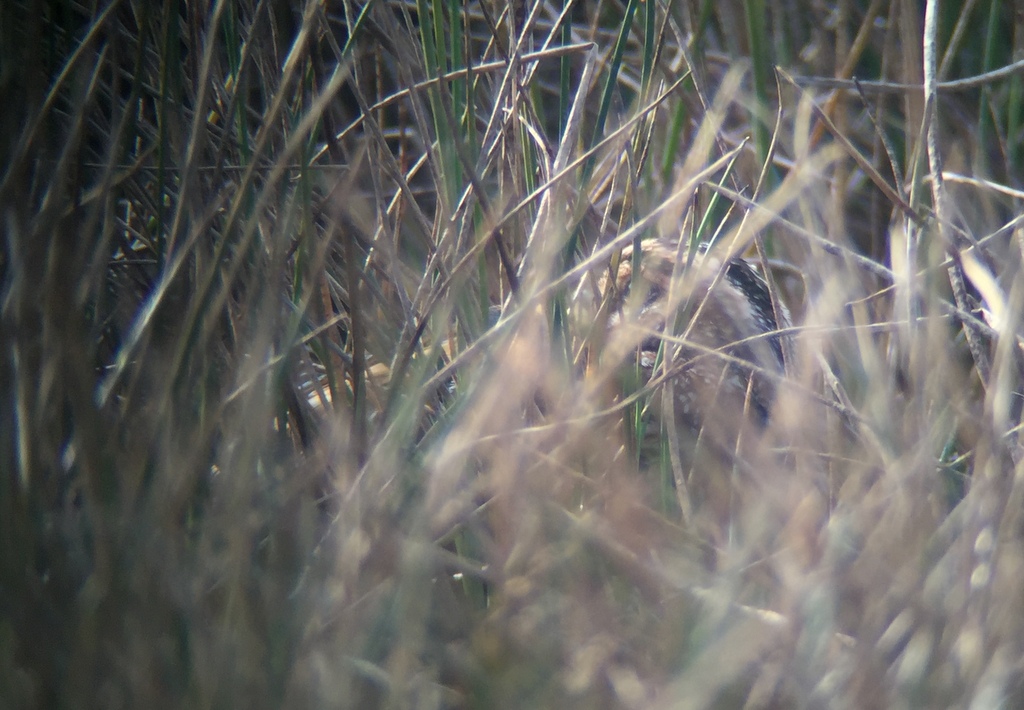 Jack Snipe – hiding deep in the grass
Jack Snipe – hiding deep in the grass
After enjoying the Jack Snipe for a while, we set off back up the lane. About half way back, we heard Bullfinches calling and a smart pink male flew out of the hedge andup the track ahead of us. It landed in a small tree with some Chaffinches, before flying back towards us and landing in the back of the hedge. We could hear it calling plaintively and a second Bullfinch answering nearby. Then it disappeared round behind the hedge.
We wanted to try to get better views of the Black Brant so we headed back to Cley next. There were only twenty or so Brent Geese off the East Bank, where it had been reported after we had seen it earlier, but it was not with them now. So we headed round to Beach Road instead. There was a much bigger flock of Brent Geese on one of the grazing meadows by the road here and a couple of cars had stopped to look at them. We joined them and after a couple of seconds the Black Brant appeared at the back of the flock.
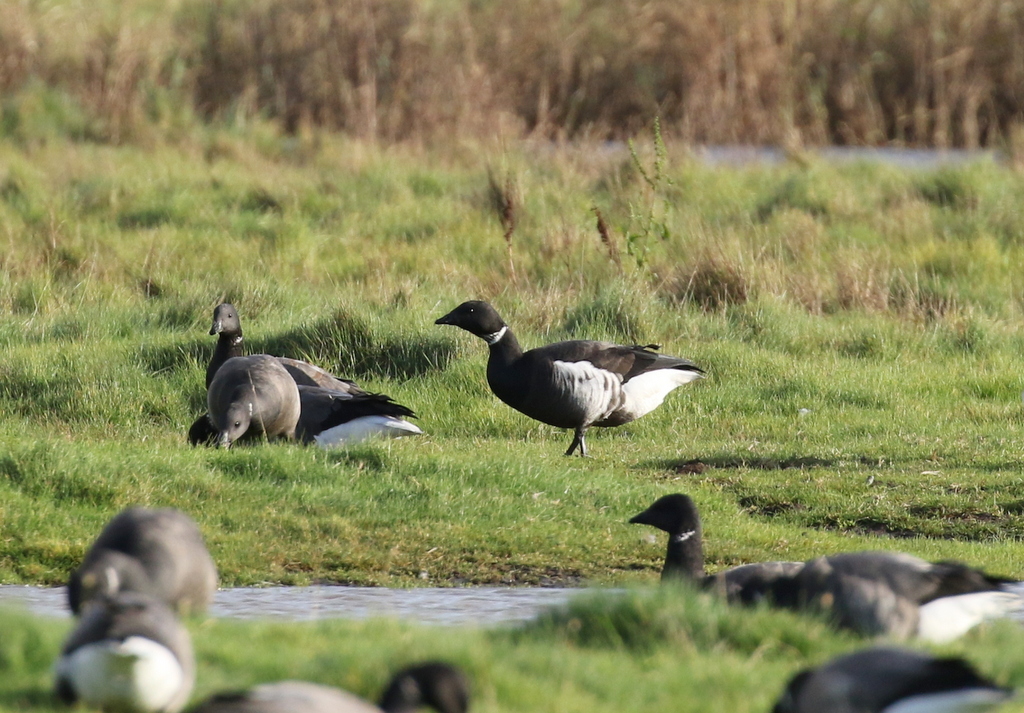 Black Brant – feeding with the Brent Geese by Beach Road early afternoon
Black Brant – feeding with the Brent Geese by Beach Road early afternoon
Through the scope, we got a really good look at the Black Brant. The white flank patch was really striking in the sunshine, very different to the more muted patches on the Dark-bellied Brents. When the Black Brant lifted its neck, we could also see its much bolder white collar, complete below the chin.
While we were watching the Black Brant, a small flock of Starlings flew over the reserve towards us, and across the road just beyond us. One of them was strikingly pale brown, but unfortunately it appeared to be just a leucistic Starling rather than anything rarer. Our timing was fortunate, because after a few minutes all the Brent Geese took off and disappeared much further out to the south side of Eye Field to join an even larger flock of Brents already there.
We continued on along Beach Road to the car park at the end and climbed up onto the shingle to have a quick look at the sea. A Grey Seal was swimming past just off the beach. A Red-throated Diver was on the sea rather distant and was diving constantly which made it harder to see. The wind had picked up a little and the sea was rather choppy too. Another Red-throated Diver flew past, along with a couple of distant Guillemots and a single adult Gannet. It was time for lunch, so we ate in the beach shelter out of the fresh breeze.
After lunch, we headed round to the East Bank. There were a few more Brent Geese feeding on the grazing marsh here now, along with several larger flocks of Wigeon. We could see more ducks out on the Serpentine, but as we walked up towards them to have a closer look we noticed a little group of waders feeding on the mud at the north end. One was noticeably smaller than the others, so we hurried straight up there and sure enough it was a Little Stint in with a group of Dunlin.
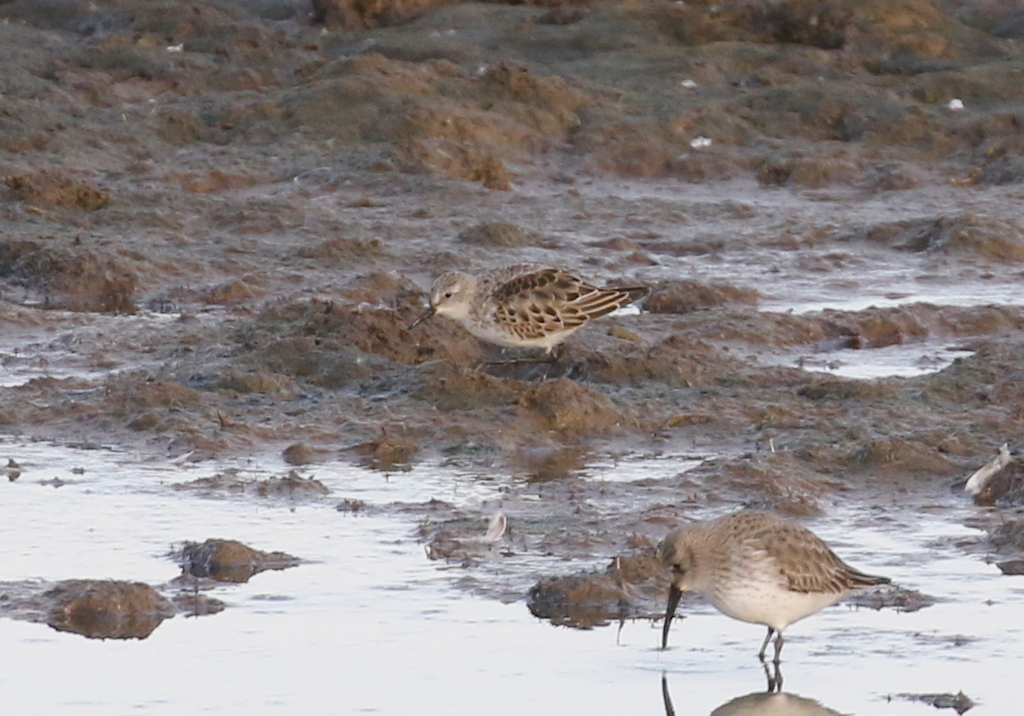 Little Stint – with a larger Dunlin in front
Little Stint – with a larger Dunlin in front
It has been a good year for Little Stints here, with a maximum count of over 40 juveniles earlier in the autumn. However, Little Stint is predominantly a passage migrant here and numbers dwindled through October, as birds moved on towards their wintering grounds around the Mediterranean or to Africa. Winter Little Stints are not unprecedented in Norfolk but are unusual, so it will be interesting to see if this one stays here now. It was a juvenile moulting to 1st winter plumage, still with quite a few retained juvenile scapulars.
As well as the Dunlin and Little Stint, there were a few Black-tailed Godwits feeding down in the water here. There was a nice selection of ducks on the Serpentine too. As well as all the Wigeon and Teal, there were several Shoveler, a small party of Gadwall and a few Pintail, the drakes of which are now looking very smart. Further back, several Cormorants were drying their wings on one of the islands on Pope’s Pool.
A Curlew was feeding on the brackish pools behind the shelter overlooking Arnold’s Marsh, but it was nice to get in the shelter out of the breeze. There didn’t seem to be much out here at first, apart from a number of Common Redshanks, but looking carefully around the edges we found several more Dunlin and three Grey Plover. A Little Egret was fishing on the pool just in front, shaking one foot at a time in the mud out in front of it, trying to flush out some food.
 Little Egret – feeding on the pool on the front edge of Arnold’s Marsh
Little Egret – feeding on the pool on the front edge of Arnold’s Marsh
With the evenings drawing in early now and a couple more things we wanted to do yet, we headed back to the car. It turned out that the Cattle Egrets had moved and were in a different field today, which is why we hadn’t found them earlier. This was more than a little unusual – one of them has been coming to the same field just about daily since mid September!
However, we didn’t have any trouble finding the Cattle Egrets now we knew where they were hiding today. We parked outside the pub in Stiffkey and they were out in the field opposite, with the cows. We had a great view of them feeding around the cows hooves, picking at the grass.
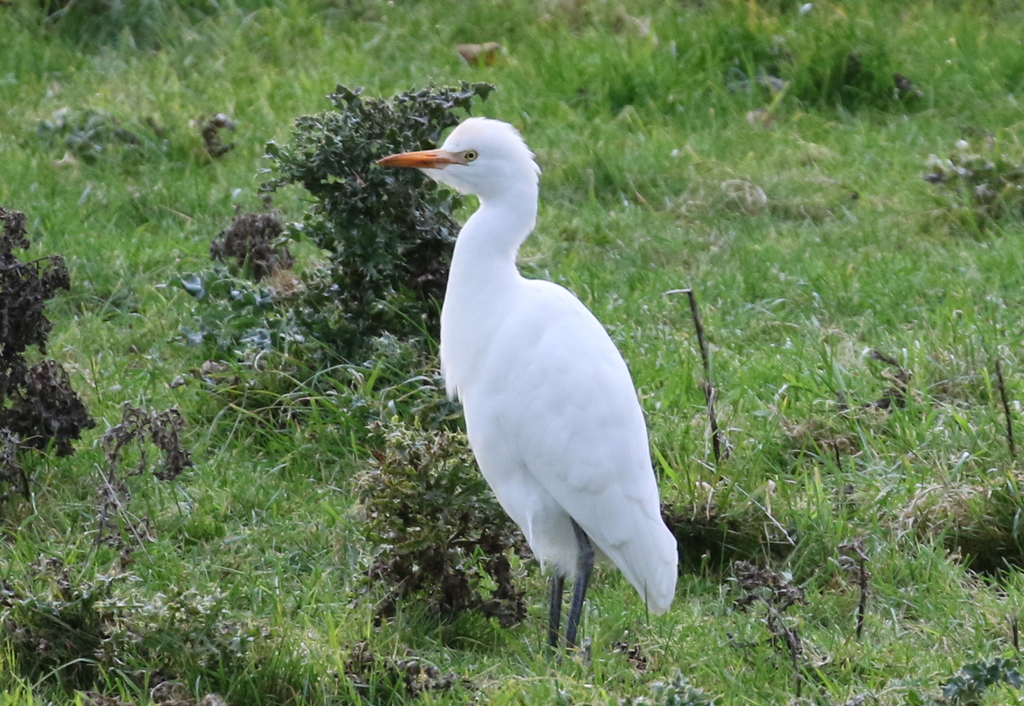 Cattle Egret – one of the two still at Stiffkey, but in a different field today!
Cattle Egret – one of the two still at Stiffkey, but in a different field today!
Our final destination for the day was at Warham Greens. As we walked up the track, we flushed several Blackbirds from the hedge. Then a small group of six Redwings flew out ahead of us too and circled round calling, before landing in the top of the hedge along the edge of one of the fields. A Common Buzzard was surveying the scene from the top of the roof of the old barn and as we walked past several Stock Doves flew out too.
From the end of the track, we stopped and scanned out across the saltmarsh. There were plenty of Little Egrets and Redshanks out in the grass, plus a few Golden Plover and Brent Geese. A Barn Owl flew through the hedge beside us and disappeared away along the edge of the saltmarsh, before landing in the bushes in the Pit.
A large flock of Fieldfares appeared over the hedge, and flew down to the Pit, landing in the tops of all the bushes and it the hedges either side. A little later, more Fieldfares appeared from over the hedge the other side of us, accompanied by a small group of Redwings. It was hard to tell, but perhaps all these thrushes had only just arrived from Scandinavia for the winter and were stopping to feed up here.
It didn’t take long to spot our first Hen Harrier, a cracking grey male which flew across the saltmarsh in front of us. It dropped down into the bushes and almost immediately we picked up a ringtail Hen Harrier which flew up and started quartering the saltmarsh further back. We saw at least 4 possibly 5 Hen Harriers this evening. Another two ringtails appeared together away in front of East Hills. Then a grey male, possibly the same as earlier having sneaked out unseen or possibly a different bird, flew in from the left. It is a real treat to see so many of them.
The light started to go, as a band of dark cloud arrived from the west. We had enjoyed lovely weather all day, which was very welcome, and thankfully only now did it start to spit lightly with rain. We decided to call it a night.
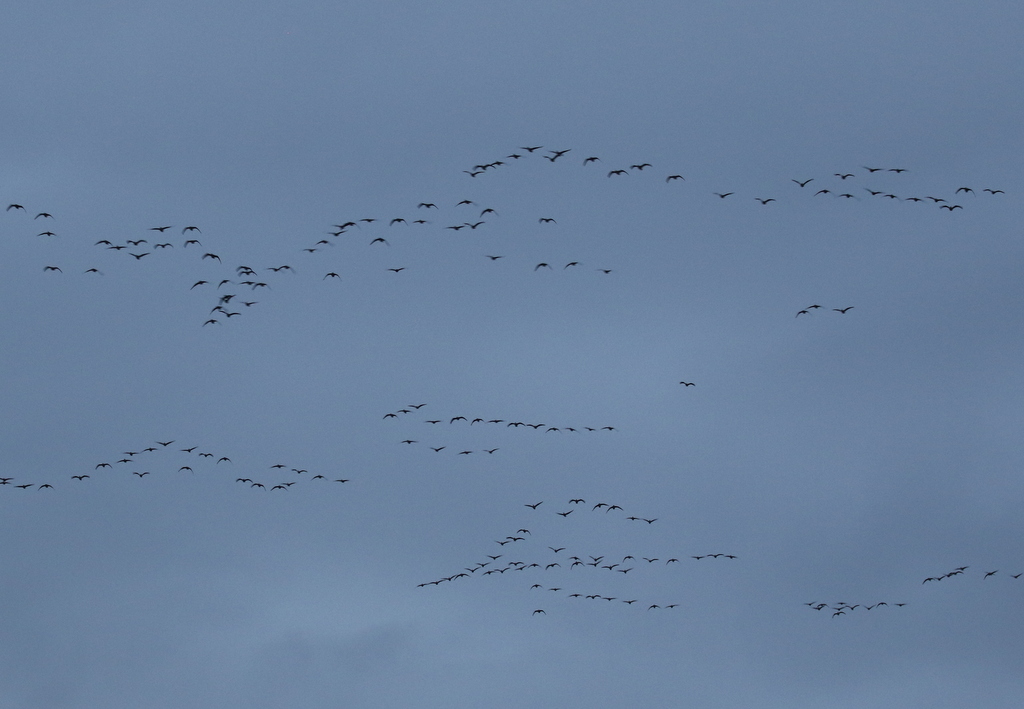 Pink-footed Geese – lines and lines of them flew out to roost at dusk
Pink-footed Geese – lines and lines of them flew out to roost at dusk
As we walked back up the track, there were several Grey Partridge calling from the fields. We could hear Pink-footed Geese too and looked up to see lines and lines of them in the sky, flying towards us. They were heading out to roost on the flats beyond the saltmarsh and it was really evocative as they flew over our heads. A great way to end the day.
















